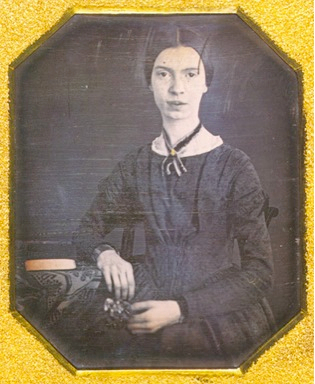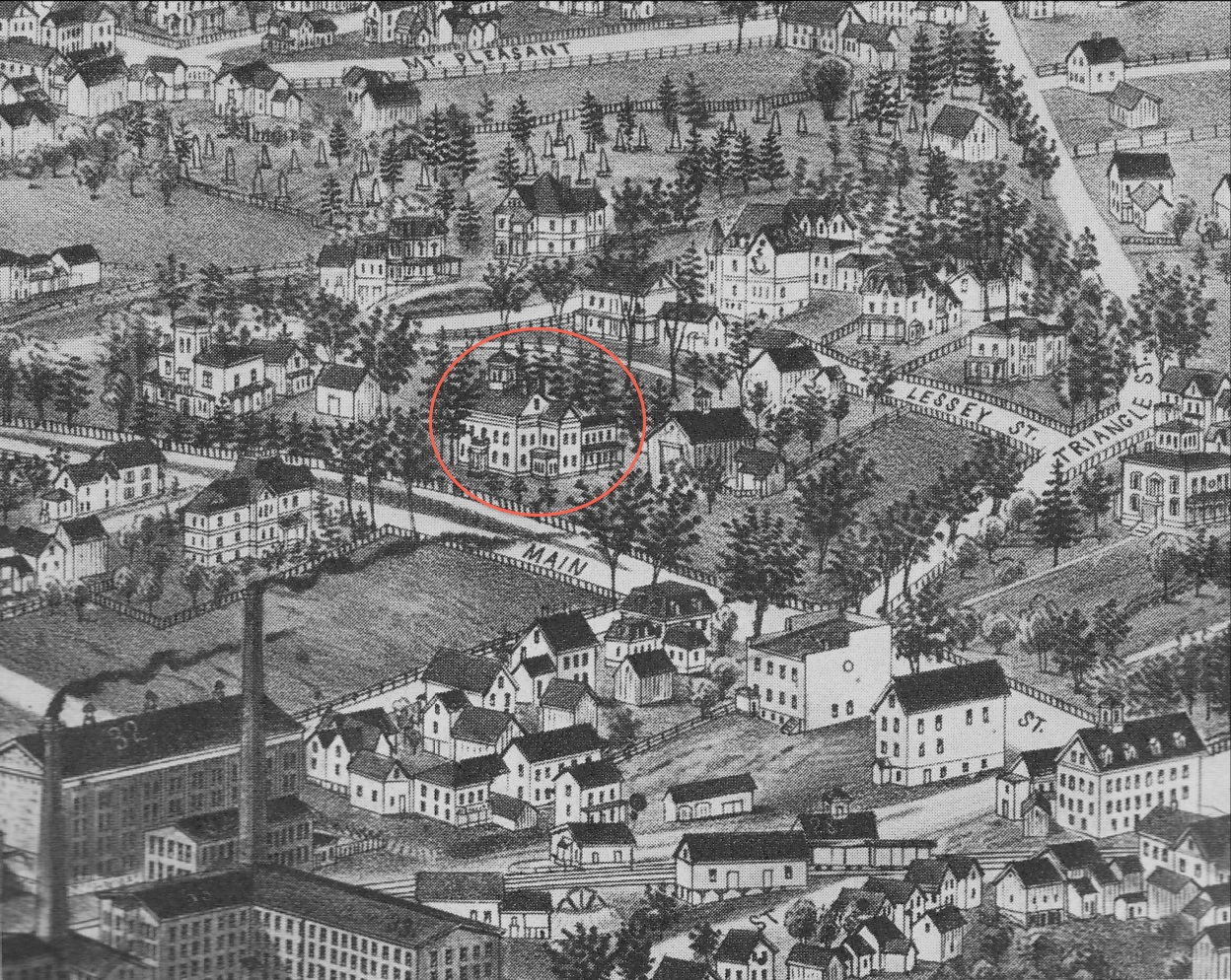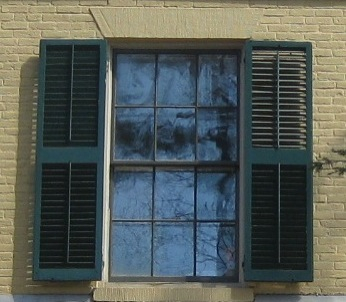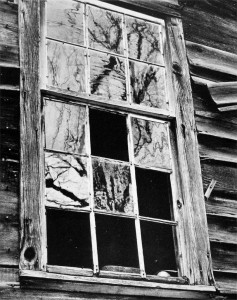by Xiao Situ
After the age of thirty, the poet Emily Dickinson rarely left her father’s house and grounds at 280 Main Street in Amherst, Massachusetts, venturing only as far as the hedges of the family estate.1 Aside from working in the garden and walking the grounds of the property, looking through windows was her primary mode of relating to the landscape around her. Fortunately for Dickinson, she lived in a house abundantly punctuated by windows.
There were approximately seventy-five windows at the Dickinson Homestead.2 Letters, poems, and others’ reminiscences of Dickinson confirm that her interactions with the windows of her home were numerous and richly associative throughout her lifetime, suffused with playful imagination, ritualistic significance, and strong emotional attachment. In a letter to her friend Mary Bowles in 1859, Dickinson wrote: “I cannot walk to the distant friends on nights piercing as these, so I put both hands on the window-pane, and try to think how birds fly, and imitate, and fail…”3 To her friend Elizabeth Holland in 1884, the poet reported: “I have made a permanent Rainbow by filling a Window with Hyacinths…”4

Figure 1. Daguerreotype of Emily Dickinson, ca. 1846. (Archives and Special Collections, Amherst College Library, Amherst, Massachusetts.)
If these windows had memories, they would consolidate enough impressions of Dickinson to create a portrait more vivid than any other we have of her today, for they would register not only her visual appearance, as the famous daguerreotype showing her at age sixteen does, but also other aspects of her full-bodied existence – the touch of her fingers on the panes, the condensation of her breath on the glass, her smell when she leaned near, and her body movements (Figure 1).
This essay argues that despite Dickinson’s intense reclusiveness, her physical proximity and dynamic relationship to her windows not only helped her feel connected to the shifting beat and tempo of the wider world that stretched beyond her immediate surroundings, but also constituted her sense of emotional and creative closeness to the anonymous artisans and laborers who produced the glass of her windows.
“By my Window have I for Scenery”
In 1886, the mapmaker and lithographer Lucien R. Burleigh produced a large, sweeping bird’s eye view of Amherst that shows – among many other features and aspects of Amherst – the Dickinson Homestead’s physical relationship to its immediate surroundings (Figure 2).

Figure 2. Close-up of Lucien R. Burleigh’s bird’s eye view of Amherst, made ca. 1886. (Jones Library Special Collections, Amherst, Massachusetts.)
The Dickinson house is circled in red. To the left of the Homestead and interspersed by a lawn dotted with trees is a large Italianate house, where Dickinson’s brother Austin lived with his wife and family. Directly across the street from the Homestead, towards the lower left, is the 11½-acre Dickinson Meadow. The meadow’s lower left corner lies in close proximity to several smokestacks, which indicate the town’s industrial quarters, consisting of factories, working-class residences, and train tracks linking Amherst to major Massachusetts rail routes.
Dickinson’s bedroom was located on the second floor at the southwest corner of the Homestead. There were four large windows in her bedroom, two facing west towards her brother’s house and two facing south towards the Dickinson Meadow. When she faced west, she saw an expansive grove of deciduous trees that formed intimate pockets of shade lining a narrow path leading to her brother’s house; this space served as a private sanctuary, cordoned off from the rest of the community by wooden gates. When she faced south, she saw the public activities of Main Street and the Dickinson Meadow, where twice a season workers were hired by her family to cut the hay and gather them into haystacks.5 Beyond the Meadow, she saw the factory smokestacks and heard the sounds of trains arriving and departing. In the far horizon, she caught a glimpse of the soft outlines of the Holyoke Mountains.6
This wider perspective, with its busy scenes of labor, commerce, and transportation, emphasized for Dickinson the many networks connecting this provincial town to the rest of New England and the eastern seaboard, reflecting her Congressman father’s Whig politics and his party’s vision for stronger interregional commerce and infrastructure. Dickinson’s bedroom thus commanded advantageous views of the town’s social, economic, and natural landscape. “By my Window have I for Scenery,” she wrote in a poem from 1864 (Fr 849) – and it was true. As literary critic Diana Fuss has pointed out, Dickinson’s bedroom was the most optically powerful room in the house – a “panoptic center.”7
Wind Eye
More than a powerful instrument of vision, Dickinson’s room was also an ideal receptacle for wind. The English word “window” is derived from the Old Norse term vindauga, meaning “wind eye,” hinting that at one time in architectural history windows contained no glass and were essentially openings in walls that allowed air to flow through.8 Dickinson’s entire bedroom, when all four windows were opened wide, could be considered a “wind eye.” The most pleasant breezes came from the southwest, sweeping across the sweetly scented meadow before it reached the Homestead. Located precisely at the southwest corner of the house at an elevated level, Dickinson’s bedchamber would have been one of the first rooms to encounter those refreshing currents.9 In her poems about wind, wind is sometimes personified as a guest – sometimes polite and gentlemanly, sometimes majestic and forceful – but nearly always a visitor or vagabond passing through the house and grounds, bringing contact from afar:
The Wind – tapped like a tired Man –
And like a Host – “Come in”
I boldly answered – entered then
My residence within
A Rapid – footless Guest –
To offer whom a Chair
Were as impossible as hand
A Sofa to the Air –
No Bone had He to bind Him –
His Speech was like the Push
Of numerous Humming Birds at once
From a superior Bush –
His Countenance – a Billow –
His Fingers, as He passed
Let go a music – as of tunes
Blown tremulous in Glass –
He visited – still flitting –
Then like a timid Man
Again, He tapped – ‘twas flurriedly –
And then I became alone –
(Fr 621)10
In The Poetics of Space, Gaston Bachelard writes that “[t]hrough the poet’s window the house converses about immensity with the world.”11 Dickinson’s contact with the world, and her understanding of her own relation to it, was framed and mediated by the windows of her home. Although tethered to a single house in a small provincial town, the windows of the Dickinson residence were a means for the poet to gain multiple perspectives; their abundance and distribution throughout the house made her inner life immense.
A World “Let Loose”

Figure 3. One of the west-facing windows of Dickinson’s second-floor bedroom in the Dickinson Homestead (Photo by author, 2012).
What happens when we shut the four windows of Dickinson’s bedroom? What do we experience when we close all the apertures of the “wind eye”? We would be confronted with many panes of glass. Since there is a historical specificity to the texture of this glass, we should examine more closely one of the Homestead windows (Figure 3).
These windows were of the standard double-hung sash format commonly found in early to mid-nineteenth-century Federal-style residences such as the Homestead.12 Such windows often featured six panes on the upper sash and six panes on the lower sash, with each pane measuring ten by sixteen inches, making the total size of the window 2½ feet wide by five feet tall. Despite this regular format, each window was greatly individualized through the diversity of marks that could remain in the body of the glass.
Paul Strand’s 1944 photograph of the double-sash window of an abandoned New England house captures some of the mesmerizing visual effects produced by nineteenth-century window glass – the kind of glass that existed in the windows of the Dickinson residence (Figure 4). Filled with residual particles of silica or clay and marked by bubbles and waving bands, the inherent imperfections in nineteenth-century window glass distorted nature’s familiar forms into fantastical patterns. The panes in Strand’s photograph appear more liquid than solid, and the tree branches reflected upon them become frenetic ink-like skeins. Looking through such glass meant seeing a world whose structures were momentarily “let loose” – an experience of nature not unlike the kind found in Dickinson’s poems, where sunrises unfurl color by color, and views of the landscape are obtained in incremental fragments:
A Slash of Blue! A Sweep of Gray!
Some scarlet patches – on the way –
Compose an evening sky –A little Purple – slipped between –
Some Ruby Trowsers – hurried on –
A Wave of Gold – a Bank of Day –
This just makes out the morning sky!(Fr 233)
I’ll tell you how the Sun rose –
A Ribbon at a time –
The Steeples swam in Amethyst –
The news, like Squirrels, ran –
The Hills untied their Bonnets –
The Bobolinks – begun –
Then I said softly to myself –
“That must have been the Sun”!(Fr 204)
The glass of the Homestead windows were of a much finer grade and quality than those of the window in Strand’s photograph, but the smokiness reflected in the panes on the upper sash in Dickinson’s window reveals its kinship to Strand’s window and its wilder reflected forms. All nineteenth-century window glass, regardless of quality or grade, had wavy, uneven surfaces; they were rarely ever uniform in thickness because the nature of window-glass production during this period did not ensure it.13 The making of window-glass in the nineteenth-century necessarily involved “a workmanship of risk.”14 Both crown and cylinder glass – the types predominantly used for domestic windows – were formed by human breath and hefty human maneuvering, and thus defied absolute uniformity no matter how well-designed a window was intended to be. No pane was absolutely smooth or flawless, and no windows had panes of identical thickness, because the human factor inherently marked and individualized the finished product. Despite the much finer quality of the glass in Dickinson’s window, it was actually a New England cousin of the glass in the window of Strand’s photograph: both were born of the same era, region, and methods of glassmaking.
Due to the uneven surfaces of the panes, the landscapes Dickinson saw through her windows did not always seamlessly cohere; subtle variations among the glass caused the framed views to sometimes appear more like glinting, shifting mosaics than stable, unified pictures, depending on where she was situated in the room and how far away she stood or sat from the windows. These subtle distortions may have influenced how Dickinson saw and what she composed: the “angles of landscape,” “slants of light,” “ribbons” of sunset or sunrise colors that so often appear in her poetry may have had a more material basis than previously thought.
Material Empathy
Such material imperfections also brought Dickinson closer to a group of individuals she could read and imagine about, but never meet face to face. In her recent book Victorian Glassworlds, the literary historian Isobel Armstrong writes:
To look through glass in the mid-nineteenth century was most likely to look through and by means of the breath of an unknown artisan. The congealed residues of somebody else’s breath remained in the window, decanter, and wineglass, traces of the workman’s body in the common bottle, annealed in the substance he worked.15
The subtle waves and miniscule bubbles in glass objects were thus the “spectral undulations” of bodily labor. When one breathed on window glass, one “awakened the dormant breath” of the worker.16 There were several glasshouses that produced window glass in Massachusetts when the Dickinson residence was built in 1813 and later renovated in 1855 – among them the Chelmsford Glass Company near Boston, the Franklin Glass Factory in Warwick, and the Berkshire Window Glasshouses in western Massachusetts.17 Any of these glassworks could have manufactured the window glass that became a part of the Dickinson Homestead. When the poet breathed on her windowpanes, she temporarily revived the New England artisans whose labor gave shape to the glass.
Dickinson very likely had a passive knowledge of glassmaking. In the February 1851 issue of Harper’s New Monthly, a periodical to which the Dickinson household subscribed and which Dickinson herself read religiously, there was an extensive article titled “The History and Mystery of the Glass-House.” It offered – rather comprehensively and in great detail – a historical, technical, and philosophical perspective on glass, and included an exhaustive description of the interior workings of a glasshouse.18 Something about the description of the working environment – the intense heat, the furnaces and caldrons, the performative virtuosity of the workers, the transformation of earthy substances such as sand and ash into refined objects, and the fusion of the makers with the tools and materials with which they worked – seemed to have made an impression on Dickinson’s imagination.
Years later, she would ask her sister-in-law to lend her an issue of the Atlantic Monthly specifically so that she could read Rebecca Harding Davis’s anonymously published short story, “Life in the Iron-Mills,” a tale about an immigrant iron-mill worker named Hugh whose inchoate artistic yearnings are suppressed through social and economic barriers. 19 The story includes a vivid description of Hugh’s working environment: it is a Vulcan-like space, with “pits of flame waving in the wind; liquid metal-flames writhing in tortuous streams…wide caldrons filled with boiling fire.”20 Hugh is an artist at heart: in his off-hours from the furnace, as he’s resting in the shade of the ironworks, he chips and molds powerfully emotive human figures out of korl, an ash waste product left after metal has been smelted from ore. At the end of the story, Hugh has died and only one of his korl sculptures remains. The narrator reflects that this gray cinder statue is all that is left to remind us of Hugh’s life. The statue’s rough planes and strained sinews have somehow absorbed Hugh’s own groping efforts to articulate his aesthetic longing for beauty through his act of sculpting.
The idea that one’s virtuosity – and indeed, one’s body – fuses with the material substance one works with, and that this virtuosity subsequently survives in a reduced form such as a cinder statue, is what binds the fictional Hugh’s fate to that of real nineteenth-century glassmakers, whose breaths and bodily efforts were absorbed into the glass objects they made. Inscribed on the 1814 tombstone of John Joseph Stickelmire, a German immigrant who was a glassblower and foreman at the Chelmsford Glass Manufactory, is this epitaph:
This verse reminds the heedless as they pass
That life’s a fragile drop of unnealed glass
The slightest wound ensures a fatal burst
And the frail fabric shivers into dust.
So he whom in his art could none surpass
Is now himself reduced to broken glass.
But from the grave, and fining pot of man
From scandiver and glass galls pursed again
New mixed and fashioned by almighty power
Shall rise a firmer fabric than before.21
This verse suggests how nineteenth-century glassmakers viewed themselves and their art: their mortal bodies as melded into and reduced to the glass artifacts they made.22 In 1865, Dickinson composed these suggestive verses:
Ashes denote that Fire was –
Revere the Grayest Pile
For the Departed Creature’s sake
That hovered there awhile –
Fire exists the first in light
And then consolidates
Only the Chemist can disclose
Into what Carbonates –(Fr 1097)
The poetry critic Helen Vendler interprets this poem as Dickinson’s meditation on her own craft: Dickinson considered her poems as only the ashes of once living and vivid experiences and observations; her poems are, in Vendler’s words, “the cryptic residue of her incandescent emotional and intellectual fires.” This poem, Vendler suggests, is about “an intense reduction of life to the embers of verse” – the transformation of virtuosity into reduced form. The poem asks the reader to revere the gray pile of ashes (the seemingly dry and lifeless verses) for the sake of the creature (the poet) that once hovered over it. As a chemist must study the ashes to discover the living thing that was once there, the reader of Dickinson’s poems must spend time with her verses to try to make their way back to the original experience – the original body – the words point to, even though it may no longer exist.23
Emotional and Creative Closeness
The act of looking through nineteenth-century glass, and through the waving bands and tiny blemishes embedded in its pellucid body, is to fleetingly make contact with the creatures (the glassmakers) that once hovered over it. Those perfected imperfections – those residual marks and uneven surfaces – remained in the glass as indicators of the laboring bodies that had handled this now solid, compact object when it was still in molten form in the heat and urgency of the glasshouse. If Dickinson indeed conceived of her creative process as the transformation and reduction of intense “emotional and intellectual fires” into a compact pile of lifeless ashes, then her small and compact poems are also perfected imperfections – the shrunken remnants of once large and powerful conflagrations.
Dickinson’s emotional attachment to the windows of the Homestead – indeed, her reliance on them for contact with the world and for poetic expression – is in many respects a dependency on and closeness to the breaths and bodies of the glassworkers. Dickinson herself recognized her physical closeness to window glass; in a poem from 1862, she describes her very soul as being pressed up against the windowpane (Fr 336).24 The fusion of the glassmaker’s efforts with the glass objects they shaped allowed them to later seep into the poet’s own craft as she looked through her windows. Her “ribbons” of colors, “slants of light,” and “angles of landscape” are as much residues of the glassmaker’s craft as they are Dickinson’s poetic creations. The windows of the poet’s home thus not only influenced how she saw and what she composed, but were also fundamentally – if finally unknowingly – sympathetic to the creation of her poems.
1. Dickinson ventured beyond 280 Main Street only twice in her thirties, both out of necessity. They were sojourns to Boston and Cambridge for eye treatment: the first took place in late April of 1864, the second in April of 1865. On Dickinson’s eye treatments in Boston, see Alfred Habegger, My Wars Are Laid Away in Books (New York: Modern Library, 2001), 483-487. The biographical information on Dickinson included in this essay comes primarily from Habegger’s biography of Dickinson and Richard B. Sewall’s The Life of Emily Dickinson (Cambridge, Massachusetts: Harvard University Press, 1974).
2. See the Emily Dickinson Museum’s Historic Structure Report, prepared by Myron O. Stachiw and Associates, June 1999, unpublished; see especially Fig. 24, n.p., which shows illustrated elevations by Thomas Paske of the Dickinson Homestead circa 1855.
3. Emily Dickinson to Mrs. Samuel [Mary] Bowles, in a letter dated 10 December 1859, reprinted in Thomas Johnson and Theodora Ward, eds., Vol. 2, The Letters of Emily Dickinson (Cambridge, Massachusetts: Belknap Press of Harvard University Press, 1958), 357.
4. Emily Dickinson to Mrs. Josiah Gilbert [Elizabeth] Holland, in a letter dated early 1884, reprinted in Vol. 3, Letters, 811.
5. On the Dickinson family’s relationship with workers, laborers, and servants, see Aífe Murray, Maid as Muse: How Servants Changed Dickinson’s Life and Language (Durham, New Hampshire: University of New Hampshire Press, 2009).
6. For descriptions of the view through Dickinson’s bedroom windows, see the Emily Dickinson Museum’s Cultural Landscape Report, prepared by Martha Lyon Landscape Architecture 2009, especially pages 13-21. See also Diana Fuss, The Sense of an Interior (New York and London: Routledge, 2004), 55-58; Jean McClure Mudge, Emily Dickinson and the Image of Home (Amherst: University of Massachusetts Press, 1975), 89-94; and Daneen Wardrop, Emily Dickinson and the Labor of Clothing (Durham, NH: University of New Hampshire Press; Hanover and London: University Press of New England, 2009), 79-80.
7. Fuss, 55-58.
8. See American Heritage Dictionary, Fifth edition, s.v. “window.”
9. For the favorable orientation of Dickinson’s room in receiving wind and breezes, see Fuss, The Sense of an Interior, 56; and The Emily Dickinson Museum, Cultural Landscape Report, prepared by Martha Lyon Landscape Architecture, LLC, 2009, unpublished, 11.
10. For Dickinson’s poems in this essay, see R. W. Franklin, ed., The Poems of Emily Dickinson: Reading Edition (Cambridge, Massachusetts, and London, England: Belknap Press of Harvard University Press, 1999).
11. Gaston Bachelard, The Poetics of Space, trans. Maria Jolas (Boston: Beacon Press, 1958, 1964, 1994), 69.
12. Susan Swiatosz, “A Technical History of Late Nineteenth-Century Windows in the United States,” Bulletin of the Association for Preservation Technology 17:1 (1985), 31.
13. Ibid, 33.
14. The term “workmanship of risk” was coined by David Pye to denote workmanship in which the quality of the resulting product is not predetermined, but depends instead on the dexterity, care, and judgment of the maker. See David Pye, The Nature and Art of Workmanship (Cambridge: Cambridge University Press, 1968), 4-5.
15. Isobel Armstrong, Victorian Glassworlds: Glass Culture and the Imagination, 1830-1880 (Oxford and New York: Oxford University Press, 2008), 4-5.
16. Ibid.
17. Kenneth M. Wilson, New England Glass and Glassmaking (Old Sturbridge, 1972), 57-66.
18. “The History and Mystery of the Glass-House,” Harper’s New Monthly (February 1851), 308-315.
19. Letter from Emily Dickinson to Susan Gilbert Dickinson, dated April 1861, reprinted in Letters of Emily Dickinson, Volume 2, 372-373.
20. [Rebecca Harding Davis,] “Life in the Iron-Mills,” in Atlantic Monthly 7:42 (April 1861), 433.
21. Quoted in Arlene Palmer Schwind, “The Glassmakers of Early America,” in The Craftsman in Early America, ed. Ian M.G. Quimby (New York and London: W.W. Norton & Company, 1984), 189.
22. Ibid.
23. For these quotes and Helen Vendler’s interpretation of this poem, see Vendler, Dickinson: Selected Poems and Commentary (Cambridge, Massachusetts, and London, England: Belknap Press of Harvard University Press, 2010), 400-403.
24. I wish to thank Nicole Bass for pointing out to me this line from a Dickinson poem as an indication of the poet’s spiritual closeness to window glass.


